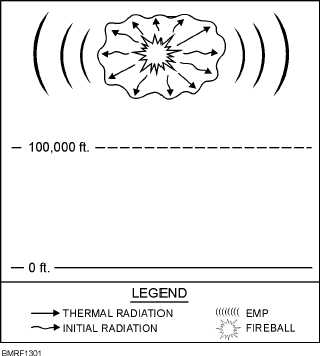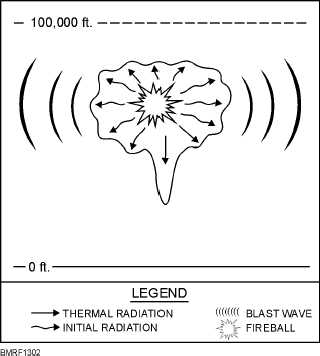In one way, nuclear weapons are no different from
ordinary high-explosive bombs—both are designed to
cause destruction by blast and shock effects. Of course,
nuclear weapons have a much greater destruction
capability than conventional high-explosive weapons,
with the added effects of nuclear radiation.
Nuclear explosions are classed according to the
point of detonation with relationship to the surface of
the earth—a high altitude blast, an air blast, a surface
blast, and a subsurface blast.
HIGH ALTITUDE BLAST
A high altitude blast (fig. 13-1) is defined as a blast
that takes place above 100,000 feet. The major aim of
this blast is to destroy or interrupt satellites and
communication systems through the effect of an
electromagnetic pulse (EMP). Basically, the EMP is an
intense electrical surge that affects electronic or
electrical equipment in a burnout that’s equivalent
(equal) to that caused by a lightning strike.
AIR BLAST
An air blast (fig. 13-2) is one in which the fireball is
below 100,000 feet and doesn’t touch the earth’s
surface. The radiation effects from an air blast are
minimal. The main reason for using an air blast is its
destructive value produced in the expansion and
compression phases of weapon detonation. The blast
causes an over pressurization that crushes everything in
its path. The front of the blast is called the mock front.
An air blast would be most effective to use against a
battle group at sea because it would structurally damage
and/or sink many ships.
SURFACE BLAST
A surface blast (fig. 13-3) is one in which the
fireball touches the earth’s surface. Most of the damage
caused by a surface blast is due to the shock (or blast)
wave that accompanies the explosion. Large amounts of
surface materials are vaporized and taken into the
fireball. As the fireball rises, more debris is sucked up by
the strong after winds. Much of this debris returns to
earth as radioactive fallout.
13-8
Student Notes:
Figure 13-1.—A high altitude blast.
Figure 13-2.—An air blast.





